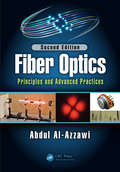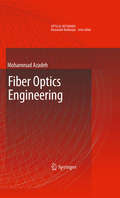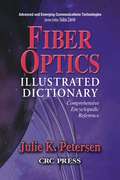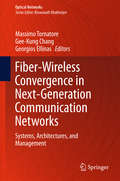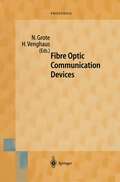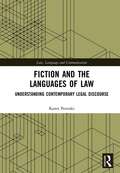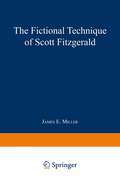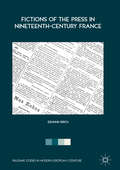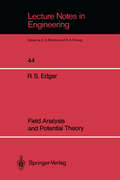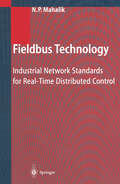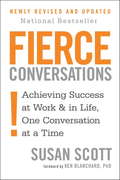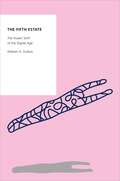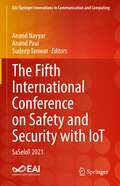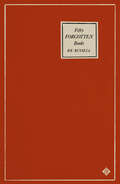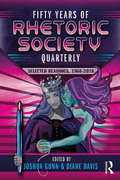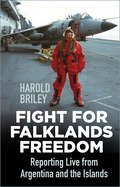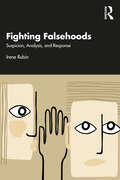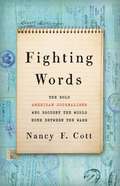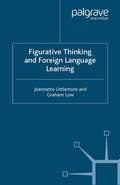- Table View
- List View
Fiber Optics: Principles and Advanced Practices, Second Edition
by Abdul Al-AzzawiThis book provides a step-by-step discussion through each topic of fiber optics. Each chapter explores theoretical concepts of principles and then applies them by using experimental cases with numerous illustrations. The book works systematically through fiber optic cables, advanced fiber optic cables, light attenuation in optical components, fiber optic cable types and installations, fiber optic connectors, passive fiber optic devices, wavelength division multiplexing, optical amplifiers, optical receivers, opto-mechanical switches, and optical fiber communications. It includes important chapters in fiber optic lighting, fiber optics testing, and laboratory safety.
Fiber Optics: Principles and Advanced Practices, Second Edition
by Abdul Al-AzzawiThis book provides a step-by-step discussion through each topic of fiber optics. Each chapter explores theoretical concepts of principles and then applies them by using experimental cases with numerous illustrations. The book works systematically through fiber optic cables, advanced fiber optic cables, light attenuation in optical components, fiber optic cable types and installations, fiber optic connectors, passive fiber optic devices, wavelength division multiplexing, optical amplifiers, optical receivers, opto-mechanical switches, and optical fiber communications. It includes important chapters in fiber optic lighting, fiber optics testing, and laboratory safety.
Fiber Optics Engineering (Optical Networks)
by Mohammad AzadehWithin the past few decades, information technologies have been evolving at a tremendous rate, causing profound changes to our world and our ways of life. In particular, fiber optics has been playing an increasingly crucial role within the telecommunication revolution. Not only most long-distance links are fiber based, but optical fibers are increasingly approaching the individual end users, providing wide bandwidth links to support all kinds of data-intensive applications such as video, voice, and data services. As an engineering discipline, fiber optics is both fascinating and challenging. Fiber optics is an area that incorporates elements from a wide range of techno- gies including optics, microelectronics, quantum electronics, semiconductors, and networking. As a result of rapid changes in almost all of these areas, fiber optics is a fast evolving field. Therefore, the need for up-to-date texts that address this growing field from an interdisciplinary perspective persists. This book presents an overview of fiber optics from a practical, engineering perspective. Therefore, in addition to topics such as lasers, detectors, and optical fibers, several topics related to electronic circuits that generate, detect, and process the optical signals are covered. In other words, this book attempts to present fiber optics not so much in terms of a field of “optics” but more from the perspective of an engineering field within “optoelectronics.
Fiber Optics Illustrated Dictionary (Advanced & Emerging Communications Technologies)
by J.K. PetersenWithin a few short years, fiber optics has skyrocketed from an interesting laboratory experiment to a billion-dollar industry. But with such meteoric growth and recent, exciting advances, even references published less than five years ago are already out of date.The Fiber Optics Illustrated Dictionary fills a gap in the literature by providing instructors, hobbyists, and top-level engineers with an accessible, current reference. From the author of the best-selling Telecommunications Illustrated Dictionary, this comprehensive reference includes fundamental physics, basic technical information for fiber splicing, installation, maintenance, and repair, and follow-up information for communications and other professionals using fiber optic components. Well-balanced, well-researched, and extensively cross-referenced, it also includes hundreds of photographs, charts, and diagrams that clarify the more complex ideas and put simpler ideas into their applications context.Fiber optics is a vibrant field, not just in terms of its growth and increasing sophistication, but also in terms of the people, places, and details that make up this challenging and rewarding industry. In addition to furnishing an authoritative, up-to-date resource for relevant industry definitions, this dictionary introduces many exciting recent applications as well as hinting at emerging future technologies.
Fiber Optics Illustrated Dictionary (Advanced & Emerging Communications Technologies)
by J.K. PetersenWithin a few short years, fiber optics has skyrocketed from an interesting laboratory experiment to a billion-dollar industry. But with such meteoric growth and recent, exciting advances, even references published less than five years ago are already out of date.The Fiber Optics Illustrated Dictionary fills a gap in the literature by providing instructors, hobbyists, and top-level engineers with an accessible, current reference. From the author of the best-selling Telecommunications Illustrated Dictionary, this comprehensive reference includes fundamental physics, basic technical information for fiber splicing, installation, maintenance, and repair, and follow-up information for communications and other professionals using fiber optic components. Well-balanced, well-researched, and extensively cross-referenced, it also includes hundreds of photographs, charts, and diagrams that clarify the more complex ideas and put simpler ideas into their applications context.Fiber optics is a vibrant field, not just in terms of its growth and increasing sophistication, but also in terms of the people, places, and details that make up this challenging and rewarding industry. In addition to furnishing an authoritative, up-to-date resource for relevant industry definitions, this dictionary introduces many exciting recent applications as well as hinting at emerging future technologies.
Fiber-Wireless Convergence in Next-Generation Communication Networks: Systems, Architectures, and Management (Optical Networks)
by Massimo Tornatore Gee-Kung Chang Georgios EllinasThis book investigates new enabling technologies for Fi-Wi convergence. The editors discuss Fi-Wi technologies at the three major network levels involved in the path towards convergence: system level, network architecture level, and network management level. The main topics will be: a. At system level: Radio over Fiber (digitalized vs. analogic, standardization, E-band and beyond) and 5G wireless technologies; b. Network architecture level: NGPON, WDM-PON, BBU Hotelling, Cloud Radio Access Networks (C-RANs), HetNets. c. Network management level: SDN for convergence, Next-generation Point-of-Presence, Wi-Fi LTE Handover, Cooperative MultiPoint.
Fibre Optic Communication Devices (Springer Series in Photonics #4)
by Norbert Grote Herbert VenghausOptoelectronic devices and fibre optics are the basis of cutting-edge communication systems. This monograph deals with the various components of these systems, including lasers, amplifiers, modulators, converters, filters, sensors, and more.
Fiction and the Languages of Law: Understanding Contemporary Legal Discourse (Law, Language and Communication)
by Karen PetroskiContemporary legal reasoning has more in common with fictional discourse than we tend to realize. Through an examination of the U.S. Supreme Court’s written output during a recent landmark term, this book exposes many of the parallels between these two special kinds of language use. Focusing on linguistic and rhetorical patterns in the dozens of reasoned opinions issued by the Court between October 2014 and June 2015, the book takes nonlawyer readers on a lively tour of contemporary American legal reasoning and acquaints legal readers with some surprising features of their own thinking and writing habits. It analyzes cases addressing a huge variety of issues, ranging from the rights of drivers stopped by the police to the decision-making processes of the Environmental Protection Agency—as well as the term’s best-known case, which recognized a constitutional right to marriage for same-sex as well as different-sex couples. Fiction and the Languages of Law reframes a number of long-running legal debates, identifies other related paradoxes within legal discourse, and traces them all to common sources: judges’ and lawyers’ habit of alternating unselfconsciously between two different attitudes toward the language they use, and a set of professional biases that tends to prevent scrutiny of that habit.
Fiction and the Languages of Law: Understanding Contemporary Legal Discourse (Law, Language and Communication)
by Karen PetroskiContemporary legal reasoning has more in common with fictional discourse than we tend to realize. Through an examination of the U.S. Supreme Court’s written output during a recent landmark term, this book exposes many of the parallels between these two special kinds of language use. Focusing on linguistic and rhetorical patterns in the dozens of reasoned opinions issued by the Court between October 2014 and June 2015, the book takes nonlawyer readers on a lively tour of contemporary American legal reasoning and acquaints legal readers with some surprising features of their own thinking and writing habits. It analyzes cases addressing a huge variety of issues, ranging from the rights of drivers stopped by the police to the decision-making processes of the Environmental Protection Agency—as well as the term’s best-known case, which recognized a constitutional right to marriage for same-sex as well as different-sex couples. Fiction and the Languages of Law reframes a number of long-running legal debates, identifies other related paradoxes within legal discourse, and traces them all to common sources: judges’ and lawyers’ habit of alternating unselfconsciously between two different attitudes toward the language they use, and a set of professional biases that tends to prevent scrutiny of that habit.
Fictions of the Press in Nineteenth-Century France (Palgrave Studies in Modern European Literature)
by Edmund BirchThis book explores how writers responded to the rise of the newspaper over the course of the nineteenth century. Taking as its subject the ceaseless intertwining of fiction and journalism at this time, it tracks the representation of newspapers and journalists in works by Honoré de Balzac, Edmond and Jules de Goncourt, and Guy de Maupassant. This was an era in which novels were published in newspapers and novelists worked as journalists. In France, fiction was to prove an utterly crucial presence at the newspaper’s heart, with a gilded array of predominant literary figures active in journalism. Today, few in search of a novel would turn to the pages of a daily newspaper. But what are usually cast as discrete realms – fiction and journalism – came, in the nineteenth century, to occupy the same space, a point which complicates our sense of the cultural history of French literature.
Field Analysis and Potential Theory (Lecture Notes in Engineering #44)
by Robert S. Edgar"Electromagnetic theory is a peculiar subject. The peculiarity resides not so much in the stratification - superposed layers of electrostatics. magnetostatics. steady currents and time-varying fields - as in the failure that has attended all attempts to weld these layers into a logical whole. The lowest layer. electrostatics. defines certain concepts. such as E. D, ~, in a way that is generally satisfactory only for the static case. Yet the attempt is made to force these specialised definitions into the higher strata, with ad hoc modifications when necessary. The student, in looking through his text books on electromagnetics, can find general definitions only with difficulty. if at all; and even the most advanced treatises fail to present a rigorously logical development of the subject". 1 So wrote Moon and Spencer some 30 years ago; and their criticism continues to be pertinent today. 2 More recently. a senior physicist of the National Bureau of Standards has expressed his concern in similar terms: "A logically consistent set of definitions of the electromagnetic field quantities is extremely difficult to find in the literature. Most text books either evade the problem or present definitions that are applicable only to special cases".
Fieldbus Technology: Industrial Network Standards for Real-Time Distributed Control
by Nitaigour P. MahalikFieldbus Technology (FT) is an enabling platform that is becoming the preferred choice for the next generation real-time automation and control solutions. This book incorporates a selection of research and development papers. Topics covered include: history and background, contemporary standards, underlying architecture, comparison between different Fieldbus systems, applications, latest innovations, new trends as well as issues such as compatibility, interoperability, and interchangeability.
Fierce Conversations: Achieving success in work and in life, one conversation at a time
by Susan ScottFierce Conversations is a way of conducting business. An attitude. A way of life. Communications expert Susan Scott maintains that a single conversation can change the trajectory of a career, marriage or life. Whether these are conversations with yourself, partner, colleagues, customers, family or friends, Fierce Conversations shows you how to have conversations that count. Scott reveals how to:*Overcome the barriers to meaningful conversations*Express who you are and what you believe*Confront tough issues with courage, confidence and sensitivity*Overcome fear to get to the heart of the problem*Inspire followers, attract believers and build visions that become reality*Bring about real change through talking*Encourage others to reveal their true opinionsPacked with exercises and questionnaires to help you have the best conversations possible, Fierce Conversations will revolutionise the way you communicate.
The Fifth Estate: The Power Shift of the Digital Age (OXFORD STUDIES DIGITAL POLITICS SERIES)
by William H. DuttonIn the eighteenth century, the printing press enabled the rise of an independent press--the Fourth Estate--that helped check the power of governments, business, and industry. In similar ways, the internet is forming a more independent collectivity of networked individuals, which William H. Dutton identifies as the Fifth Estate. Their network power is contributing to a more pluralist role of individuals in democratic political processes and society, which is not only shaping political accountability but nearly every sector of society. Yet a chorus of critics have dismissed the internet's more democratic potentials, demonizing social media and user-generated-content as simply sources of fake news and populism. So, is the internet a tool for democracy or anarchy? In The Fifth Estate, Dutton uses estate theory to illuminate the most important power shift of the digital age. He argues that this network power shift is not only enabling greater democratic accountability in politics and governance but is also empowering networked individuals in their everyday life and work, from checking facts to making civic-minded social interventions. By marshalling world leading research and case studies in a wide range of contexts, Dutton demonstrates that the internet and related digital media are enabling ordinary individuals to search, create, network, collaborate, and leak information in such independent and strategic ways that they enhance their informational and communicative power vis-à-vis other actors and institutions. Dutton also makes the case that internet policy interventions across the globe have increased censorship of users and introduced levels of surveillance that will challenge the vitality of the internet and the Fifth Estate, along with its more pluralist distribution of power. Ambitious and timely, Dutton provides an understanding of the Fifth Estate and its democratic potential so that networked individuals and institutions around the world can maintain and enhance its role in our digital age.
The Fifth Estate: The Power Shift of the Digital Age (OXFORD STUDIES DIGITAL POLITICS SERIES)
by William H. DuttonIn the eighteenth century, the printing press enabled the rise of an independent press--the Fourth Estate--that helped check the power of governments, business, and industry. In similar ways, the internet is forming a more independent collectivity of networked individuals, which William H. Dutton identifies as the Fifth Estate. Their network power is contributing to a more pluralist role of individuals in democratic political processes and society, which is not only shaping political accountability but nearly every sector of society. Yet a chorus of critics have dismissed the internet's more democratic potentials, demonizing social media and user-generated-content as simply sources of fake news and populism. So, is the internet a tool for democracy or anarchy? In The Fifth Estate, Dutton uses estate theory to illuminate the most important power shift of the digital age. He argues that this network power shift is not only enabling greater democratic accountability in politics and governance but is also empowering networked individuals in their everyday life and work, from checking facts to making civic-minded social interventions. By marshalling world leading research and case studies in a wide range of contexts, Dutton demonstrates that the internet and related digital media are enabling ordinary individuals to search, create, network, collaborate, and leak information in such independent and strategic ways that they enhance their informational and communicative power vis-à-vis other actors and institutions. Dutton also makes the case that internet policy interventions across the globe have increased censorship of users and introduced levels of surveillance that will challenge the vitality of the internet and the Fifth Estate, along with its more pluralist distribution of power. Ambitious and timely, Dutton provides an understanding of the Fifth Estate and its democratic potential so that networked individuals and institutions around the world can maintain and enhance its role in our digital age.
The Fifth International Conference on Safety and Security with IoT: SaSeIoT 2021 (EAI/Springer Innovations in Communication and Computing)
by Anand Nayyar Anand Paul Sudeep TanwarThis book presents the Fifth International Conference on Safety and Security with IoT (SaSeIoT 2021), which took place online. The conference aims to explore not only IoT and its related critical applications but also IoT towards Security and Safety. The conference solicits original and inspiring research contributions from experts, researchers, designers, and practitioners in academia, industry and related fields and provides a common platform to share knowledge, experience and best practices in various domains of IoT.
Fifty Forgotten Books
by R. B. RussellFifty Forgotten Books is a very special sort of book about books, by a great bibliophile and for book-lovers of all ages and levels of experience. Not quite literary criticism, not quite an autobiography, it is at once a guided tour through the dusty backrooms of long vanished used bookstores, a love letter to bookshops and bookselling, and a browser’s dream wish list of often overlooked and unloved novels, short story collections, poetry collections and works of nonfiction. In these pages, R. B. Russell, publisher of Tartarus Press, doesn’t only discuss the books of his life, but explains what they have meant to him over time, charting his progress as a writer and publisher for over thirty years, and a bibliophile for many more. Here is living proof of how literature, books, and book collecting can be an intrinsic part of one’s personal, professional and imaginative life, and as not only a solitary act, but a social one, resulting in treasured friendships, experiences, and loves one might never, otherwise, have enjoyed. Filled with a lively nostalgia for the era when finding strange new books meant pounding the pavement and not just searching booksellers’ websites, Fifty Forgotten Books is for anyone who wishes they could still browse the dusty bookshelves of their youth, and who can't wait to get back out into the world in quest of the next text liable to change their life.
Fifty Years of Rhetoric Society Quarterly: Selected Readings, 1968-2018
by Joshua Gunn Diane DavisFifty Years of Rhetoric Society Quarterly: Selected Readings, 1968-2018 celebrates the semicentennial of Rhetoric Society Quarterly, bringing together the most influential essays included in the journal over the past fifty years. Assessed by members of the Rhetoric Society of America, this collection provides advanced undergraduate and graduate students with a balanced perspective on rhetorical theory and practice from scholars in both communication studies and rhetoric and writing studies. The volume covers a range of themes, from the history of rhetorical studies, writing and speaking pedagogy, and feminism, to the work of Kenneth Burke, the rhetoric of science, and rhetorical agency.
Fifty Years of Rhetoric Society Quarterly: Selected Readings, 1968-2018
by Joshua Gunn Diane DavisFifty Years of Rhetoric Society Quarterly: Selected Readings, 1968-2018 celebrates the semicentennial of Rhetoric Society Quarterly, bringing together the most influential essays included in the journal over the past fifty years. Assessed by members of the Rhetoric Society of America, this collection provides advanced undergraduate and graduate students with a balanced perspective on rhetorical theory and practice from scholars in both communication studies and rhetoric and writing studies. The volume covers a range of themes, from the history of rhetorical studies, writing and speaking pedagogy, and feminism, to the work of Kenneth Burke, the rhetoric of science, and rhetorical agency.
Fight for Falklands Freedom: Reporting Live from Argentina and the Islands
by Harold BrileyThe world was told about the Falkland Islands invasion by radio, the news sweeping across the globe. Historian and war correspondent Sir Max Hastings, reporting from the Falkland Islands front-line, called it ‘the Radio Man’s War’ because it had a wider and quicker global reach. Harold Briley was the BBC ‘radio man’ in Buenos Aires. He broke the story on the BBC World Service and brought the Falklands saga to life. Previously the Falkland Islands were virtually unknown, but after Argentina invaded, and Britain reacted sending a Task Force 8,000 miles to liberate the Islanders, they made the front pages overnight. Harold Briley recounts the events of the time, from his eyewitness standpoint, as the man on the ground in Argentina. This book both recounts events and explains the attitude of the Falklands before and since the conflict, and the activities of the Argentine dictatorship intent on getting sovereignty.
Fighting Falsehoods: Suspicion, Analysis, and Response
by Irene RubinThis book offers the reader tools to recognize, analyze, and fight back against the fake news, misinformation, and disinformation that come at us from every corner. This volume: Uses real, lively examples to help readers detect fake news, false claims, suspicious information/data, biased reporting, and hate speech; Demonstrates through case studies where to look for information, what to look for, how to analyze the logic/illogic involved, and uncover the truth value of a story; Discusses fact-checking sites, what they examine, and their reliability; Provides examples and analyzes the components, purposes, and consequences of conspiracy theories; Illustrates the tricks of using numbers/data to mislead readers; Explains what to look for to help decide whether to believe the conclusions of stories based on surveys; Offers a range of concrete, effective responses to dangerous, exaggerated, distorted, and false narratives; Examines policy responses to fake news, disinformation, and misinformation across the world. A key manual to negotiate the information age, this book will be essential reading for students, scholars, and professionals of journalism and mass communication, public policy, politics, and the social sciences. It will also be an indispensable handbook for the lay reader.
Fighting Falsehoods: Suspicion, Analysis, and Response
by Irene RubinThis book offers the reader tools to recognize, analyze, and fight back against the fake news, misinformation, and disinformation that come at us from every corner. This volume: Uses real, lively examples to help readers detect fake news, false claims, suspicious information/data, biased reporting, and hate speech; Demonstrates through case studies where to look for information, what to look for, how to analyze the logic/illogic involved, and uncover the truth value of a story; Discusses fact-checking sites, what they examine, and their reliability; Provides examples and analyzes the components, purposes, and consequences of conspiracy theories; Illustrates the tricks of using numbers/data to mislead readers; Explains what to look for to help decide whether to believe the conclusions of stories based on surveys; Offers a range of concrete, effective responses to dangerous, exaggerated, distorted, and false narratives; Examines policy responses to fake news, disinformation, and misinformation across the world. A key manual to negotiate the information age, this book will be essential reading for students, scholars, and professionals of journalism and mass communication, public policy, politics, and the social sciences. It will also be an indispensable handbook for the lay reader.
Fighting Words: The Bold American Journalists Who Brought the World Home Between the Wars
by Nancy F. CottFrom a Harvard historian, this riveting portrait of four trailblazing American journalists highlights the power of the press in the interwar period. In the fragile peace following the Great War, a surprising number of restless young Americans abandoned their homes and set out impulsively to see the changing world. In Fighting Words, Nancy F. Cott follows four who pursued global news -- from contested Palestine to revolutionary China, from Stalin's Moscow to Hitler's Berlin. As foreign correspondents, they became players in international politics and shaped Americans' awareness of critical interwar crises, the spreading menace of European fascism, and the likelihood of a new war -- while living romantic and sexual lives as modern and as hazardous as their journalism. An indelible portrayal of a tumultuous era with resonance for our own, Fighting Words is essential reading on the power of the press and the growth of an American sense of international responsibility.
Figurative Thinking and Foreign Language Learning
by J. Littlemore Graham D. LowMany vocabulary items that foreign language learners encounter involve figurative extensions of meaning. To understand figurative speech, learners often need to employ figurative thinking. This book examines figurative thinking, considers its contribution to language ability, and explores the implications for language teaching and learning.
